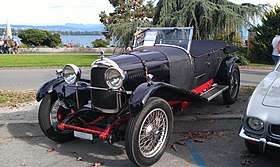Lagonda 14/60
The Lagonda 14/60 was a sports touring car introduced by Lagonda in 1925. Production of the 14/60 continued until 1931. As well as the standard car there were variants called the 2 Litre Speed (1927–33) and Continental (1932 only).
| Lagonda 14/60 or 2 Litre | |
|---|---|
 | |
| Overview | |
| Manufacturer | Lagonda |
| Production | 1925–1933[1] |
| Body and chassis | |
| Body style | 2 door sports, 4-door tourer, 4 door saloon |
| Powertrain | |
| Engine | 1954 cc ohv 4 cylinder |
| Dimensions | |
| Wheelbase | 120 in (3,048 mm)[2] |
| Length | 162 in (4,115 mm)[2] |
| Width | 68 in (1,727 mm)[2] |
| Chronology | |
| Predecessor | Lagonda 12/24 |
| Successor | Lagonda 16/80 |
The first part of its name referred to its Fiscal horsepower rating of 14 (actually 12.9) and the second part the engine output in bhp.
According to the Lagonda Club, around 1440 cars were made.
Engine and transmission
The engine was a new design for the car by Arthur Davidson who had been with Lea-Francis. The 4 cylinder, 1954 cc unit was notable for its valve gear. Two camshafts were mounted high on each side of the engine block and operated the overhead valves via rockers mounted in the head that had fingers that followed the camshafts. This allowed the cylinder head, which unlike previous Lagondas was detachable, with its hemi-spherical combustion chambers to be removed without disturbing the valve timing. The camshafts were driven by a two-stage chain arrangement, the first chain also drove the dynamo, oil and water pumps.[3] The crankshaft was carried in five main bearings. A single Zenith carburettor was fitted. With a bore of 72mm and stroke of 120mm the engine was said to produce 60bhp at 3500rpm.[2]
The four-speed gearbox was separate from the engine and driven through a single dry-plate clutch. An open shaft then went to the spiral-bevel rear axle.
Chassis and suspension
The chassis design was by A. E. Masters [4] and consisted of side members held apart by a combination of tubular and channed cross members. Semi-elliptical leaf springs were fitted front and rear. 14 in (356 mm) drum brakes operated by rods and cables were fitted on all four wheels with separate shoes in the rear brakes for the handbrake.
Coachwork
Three standard body styles were available for the 14/60, a saloon, a tourer and an open semi-sports with V-shaped windscreen. The saloon and tourer were designed to accommodate five people but the slightly narrower sports only four. Early cars were fitted with steel artillery type wheels but later cars had wire wheels. Some chassis went to external coachbulders.
2 Litre Speed Model
In 1927 the Speed model was announced. The engine was tuned to give 70 bhp by raising the compression ratio and with a lighter body was guaranteed to reach 80 mph (130 km/h). The chassis was modified to allow the engine to be mounted 9 in (229 mm) further back giving a much longer bonnet. Standard bodies were a tourer or fabric saloon.
For 1929 the chassis was further modified and has become known as the "low-chassis" version. The radiator was also altered as the dynamo was moved to the front of the crankshaft.
A supercharged version was announced in 1930 said to be capable of 90 mph (140 km/h).
Continental
.jpg)
In 1932 a new model was announced called the Continental. Its tourer body was made of steel and the radiator was inclined slightly and had thermostatic shutters. Cycle type front wings were fitted and there were large Lucas P100 headlamps. The car cost an extra GBP30 and 23 were made.[5]
References
- Sedgwick, M. (1989). A-Z of Cars of the 1930s. Devon, UK: Bay View Books. ISBN 1-870979-38-9.
- Culshaw; Horrobin (1974). Complete Catalogue of British Cars. London: Macmillan. ISBN 0-333-16689-2.
- Walker (2007). British Sports and Thoroughbred Motor Cars. UK: Herridge. ISBN 978-1-906133-01-6.
- Baldwin, Nick. (1994). A-Z of Cars of the 1920s. Devon, UK: Bay View Books. ISBN 1-870979-53-2.
- Ware, M (November 2012). "Back on the Road". The Automobile. 30: 60. ISSN 0955-1328.